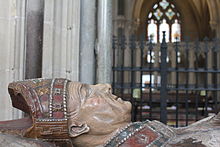Thomas Beckington
Thomas Beckington | |
|---|---|
| Bishop of Bath and Wells | |
 | |
| Appointed | before 13 October 1443 |
| Term ended | 14 January 1465 |
| Predecessor | John Stafford |
| Successor | Robert Stillington |
| Orders | |
| Consecration | 13 October 1443 |
| Personal details | |
| Born | c.1390 Beckington,Somerset |
| Died | 14 January 1465 Wells |
| Denomination | Roman Catholic |
| Previous post(s) | Dean of Arches |
Thomas Beckington(also speltBeckynton;c.1390 – 14 January 1465) was theBishop of Bath and WellsandKing's Secretaryin medieval England underHenry VI.
Life
[edit]Beckington was born atBeckingtoninSomerset,and was educated atWinchesterandNew College, Oxford.Having entered the Church he held many ecclesiastical appointments, and becamedean of the Archesin 1423;[1]andArchdeacon of Buckinghamin 1424. After that he devoted his time to secular affairs and was sent on an embassy toCalaisin 1439 and toJohn IV, Count of Armagnacin 1442.[2]
At this time Beckington was acting as secretary to Henry VI, and soon after his return in 1443 he was appointedLord Privy Seal,an office he held until 1444.[3]He was consecrated Bishop of Bath and Wells on 13 October 1443.[4]The bishop erected many buildings inWellsand elsewhere, probably alteringthe rectory at Sutton CourtenayinBerkshire(nowOxfordshire), an early preferment. The most important results of Beckington's missions to France were oneLatinjournal, written by himself, referring to the embassy to Calais; and another, written by one of his attendants, relating to the journey toArmagnac.[2]He died at Wells on 14 January 1465.[4]
Beckington is buried atWells Cathedraland has an unusual monument there: his effigy is depicted twice; one above the other in a two tier arrangement, the bottom effigy depicting his decaying corpse whilst unwrapped from its shroud, and the effigy above depicting him in what is assumed to be his bishop's attire. When his tomb was opened during Victorian times he was found to be buried very simply (as depicted on his tomb) with just one ornament: hisbishop's ring.This was removed and is now in a museum.
Beckington played a leading role as architect of the legal aspects of Henry VI's foundation ofEton Collegein 1440; he is commemorated in the name of the school's central dining hall, 'Bekynton'.
In a letter from 1449, Beckington remarked ofBathmentioning that the healing waters of Bath has been turned into abuse by the shamelessness of the inhabitants of the city. Further mentioning:[5]
"by... custom of the city, [the people] shamelessly strip them of their said garments and reveal to them to the gaze of bystanders."
Bekynton's architecture is marked with a symbol depicting a barrel and a flame. This is a pun on his name, being "beacon tun". One of the easiest to be viewed is in Penniless Porch Wells.
Works
[edit]Beckington's own journal was published in theProceedings of the Privy Council,vol. v., edited byNicholas Harris Nicolas(1835); and the other journal in theOfficial Correspondence of Thomas Bekynton,edited byGeorge Williamsfor theRolls Series(1872), which contains many interesting letters. This second journal was translated into English by Nicolas (1828).[6][2]
See also
[edit]Citations
[edit]- ^Burton 1912.
- ^abcChisholm 1911.
- ^Fryde et al. 1996,p. 95.
- ^abFryde et al. 1996,p. 228.
- ^Kibblewhite, Gideon; McDonnell, Kate; Harris, Perry (2015).Beastly Bath.History Press Limited.ISBN9780750959681.
- ^Perry 1894.
References
[edit]- Burton, Edwin Hubert (1912)..In Herbermann, Charles (ed.).Catholic Encyclopedia.Vol. 14. New York: Robert Appleton Company.
- Dunning, Robert W. "Beckington, Thomas (1390?–1465)".Oxford Dictionary of National Biography(online ed.). Oxford University Press.doi:10.1093/ref:odnb/1908.(Subscription orUK public library membershiprequired.)
- Fryde, E. B.; Greenway, D. E.; Porter, S.; Roy, I. (1996).Handbook of British Chronology(3rd ed.). Cambridge University Press.ISBN978-0-521-56350-5.
- Gairdner, James (1885)..InStephen, Leslie(ed.).Dictionary of National Biography.Vol. 4. London: Smith, Elder & Co.
- This article incorporates text from a publication now in thepublic domain:Chisholm, Hugh,ed. (1911). "Beckington, Thomas".Encyclopædia Britannica.Vol. 3 (11th ed.). Cambridge University Press. p. 610.
- Perry, George Gresley(April 1894). "Bishop Beckington and Henry VI".The English Historical Review.9(34): 261–274.JSTOR548366.
External links
[edit]
- 1390 births
- 1465 deaths
- 15th-century English Roman Catholic bishops
- Alumni of New College, Oxford
- Archdeacons of Buckingham
- Bishops of Bath and Wells
- 15th-century English diplomats
- Lords Privy Seal
- People educated at Winchester College
- People from Mendip District
- People from Sutton Courtenay
- Burials at Wells Cathedral
